
A sauna is a room or building designed as a place to experience dry or wet heat sessions, or an establishment with one or more of these facilities. The steam and high heat make the bathers perspire. A thermometer in a sauna is typically used to measure temperature; a hygrometer can be used to measure levels of humidity or steam. Infrared therapy is often referred to as a type of sauna, but according to the Finnish sauna organizations, infrared is not a sauna.

A towel is a piece of absorbent cloth or paper used for drying or wiping a surface. Towels draw moisture through direct contact.

A bathroom, restroom or washroom is a room, typically in a home or other residential building, that contains either a bathtub or a shower. The inclusion of a sink is common. In parts of the world e.g. India, a toilet is typically included in the bathroom; in others, the toilet is typically given a dedicated room separate from the one allocated for personal hygiene activities. In the United States and Canada, the word "bathroom" is often used to refer to any room that contains a toilet, regardless of the inclusion of a bath or shower.

Sentō (銭湯) is a type of Japanese communal bathhouse where customers pay for entrance. Traditionally these bathhouses have been quite utilitarian, with a tall barrier separating the sexes within one large room, a minimum of lined-up faucets on both sides, and a single large bath for the already washed bathers to sit in among others. Since the second half of the 20th century, these communal bathhouses have been decreasing in numbers as more and more Japanese residences now have baths. Some Japanese find social importance in going to public baths, out of the theory that physical proximity/intimacy brings emotional intimacy, which is termed skinship in pseudo-English Japanese. Others go to a sentō because they live in a small housing facility without a private bath or to enjoy bathing in a spacious room and to relax in saunas or jet baths that often accompany new or renovated sentōs.

A hammam or Turkish bath is a type of steam bath or a place of public bathing associated with the Islamic world. It is a prominent feature in the culture of the Muslim world and was inherited from the model of the Roman thermae. Muslim bathhouses or hammams were historically found across the Middle East, North Africa, al-Andalus, Central Asia, the Indian subcontinent, and in Southeastern Europe under Ottoman rule. A variation on the Muslim bathhouse, Victorian Turkish baths, became popular as a form of therapy, a method of cleansing, and a place for relaxation during the Victorian era, rapidly spreading through the British Empire, the United States, and Western Europe.

In ancient Rome, thermae and balneae were facilities for bathing. Thermae usually refers to the large imperial bath complexes, while balneae were smaller-scale facilities, public or private, that existed in great numbers throughout Rome.

Bathing is the act of washing the body, usually with water, or the immersion of the body in water. It may be for personal hygiene, religious ritual or therapeutic purposes. By analogy, especially as a recreational activity, the term is also applied to sun bathing and sea bathing.
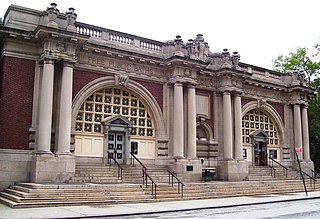
Public baths originated when most people in population centers did not have access to private bathing facilities. Though termed "public", they have often been restricted according to gender, religious affiliation, personal membership, and other criteria.

A banya is originally a Russian steam bath with a wood stove. It is considered an important part of Russian culture. The bath takes place in a small room or building designed for dry or wet heat sessions. The steam and high heat make the bathers perspire. Genders were traditionally segregated in the banya, with separate rooms for each sex.

Rudas Bath or Rudas fürdő is a thermal bath in Budapest, Hungary which is claimed to have medicinal properties. It was founded in 1571/1572 during the time of Ottoman rule. To date, it retains many of the key elements of a Hammam, exemplified by its Ottoman dome and octagonal pool. It is located at Döbrentei tér 9 on the Buda side of Erzsébet Bridge. The bath has six therapy pools and one swimming pool where the temperature is in between 10 and 42 °C. The components of slightly radioactive thermal water includes sulfate, calcium, magnesium, bicarbonate and a significant amount of fluoride ion. A sight-seeing brochure claims the water can help to treat degenerative joint illnesses, chronic and sub-acute joint inflammations, vertebral disk problems, neuralgia and lack of calcium in the bone system.
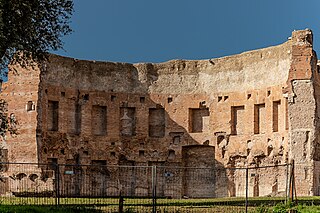
Bathing played a major part in ancient Roman culture and society. It was one of the most common daily activities and was practised across a wide variety of social classes. Though many contemporary cultures see bathing as a very private activity conducted in the home, bathing in Rome was a communal activity. While the extremely wealthy could afford bathing facilities in their homes, private baths were very uncommon, and most people bathed in the communal baths (thermae). In some ways, these resembled modern-day destination spas as there were facilities for a variety of activities from exercising to sunbathing to swimming and massage.

A steam bath is a steam-filled room for the purpose of relaxation and cleansing. It has a long history, going back to Greek and Roman times.
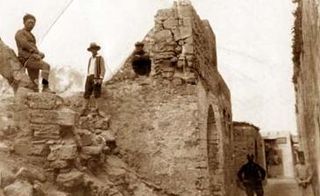
Hamam al-Sammara was the only active hammam remaining in Gaza, located in the Zeitoun Quarter of the Old City. It was situated 3 meters (9.8 ft) below street level. It was owned by Salim Abdullah al-Wazeer. The bathhouse was destroyed by airstrike from Israeli forces in December 2023.

The Lukács Thermal Bath is a historic indoor/outdoor thermal bath spa in Budapest, Hungary, heated by natural hot springs. All pools and four saunas can be used by all guests except for the optional area of the sauna world, which contains five more saunas, ice cooling pool, igloo and heated roman bench.

Hammam al-Nahhasin is one of the oldest and largest public baths in Aleppo, Syria. It is located in Al-Madina Souq of the Ancient City of Aleppo, to the south of the Great Umayyad Mosque, near Khan al-Nahhasin.
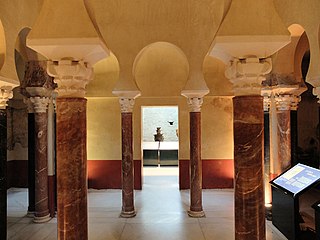
The Caliphal Baths are an Islamic bathhouse complex in Córdoba, Spain. They are situated in the historic centre which was declared a World Heritage Site by UNESCO in 1994. The complex was contiguous to the former Caliphal Palaces of the Umayyads, whose inhabitants it served. Today the baths have been partially reconstructed and are open as a museum.

The Shahi Hammam, also known as the Wazir Khan Hammam, is a Turkish bath which was built in Lahore, Pakistan, in 1635 C.E. during the reign of Emperor Shah Jahan. It was built by chief physician to the Mughal Court, Ilam-ud-din Ansari, who was widely known as Wazir Khan. The baths were built to serve as a waqf, or endowment, for the maintenance of the Wazir Khan Mosque.
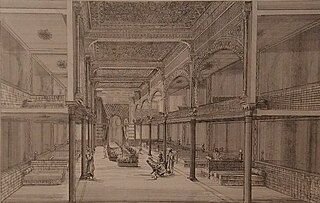
The Victorian Turkish bath is a type of bath in which the bather sweats freely in hot dry air, is then washed, often massaged, and has a cold wash or shower. It can also mean, especially when used in the plural, an establishment where such a bath is available.

The Bañuelo or El Bañuelo, also known as the Baño del Nogal or Hammam al-Yawza, is a preserved historic hammam in Granada, Spain. It is located in the Albaicin quarter of the city, on the banks of the Darro River. It was used as a bathhouse up until the 16th century at least, before becoming defunct and being converted to other uses. In the 20th century it underwent numerous restorations by Spanish experts and is now open as a tourist attraction.


















